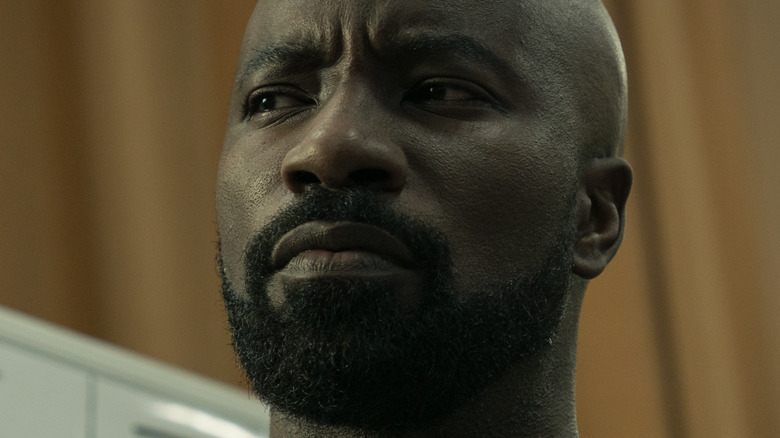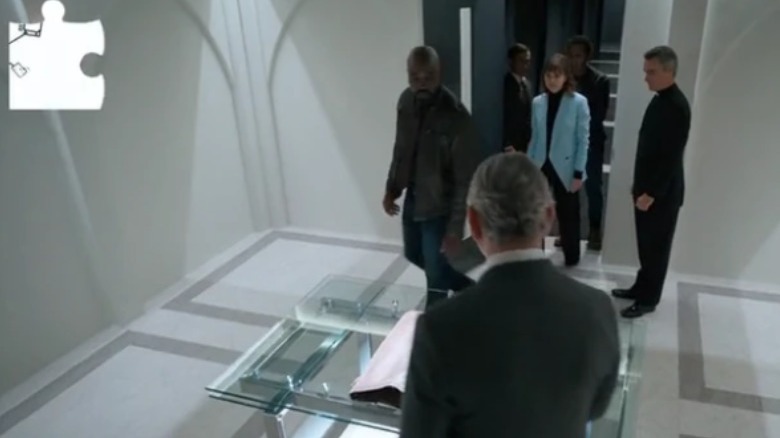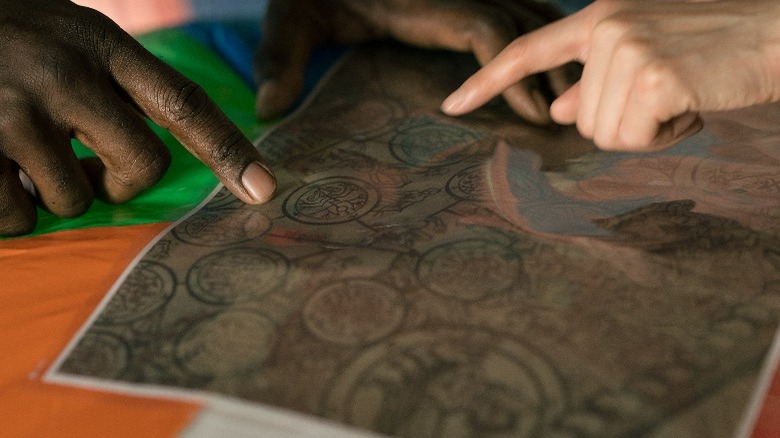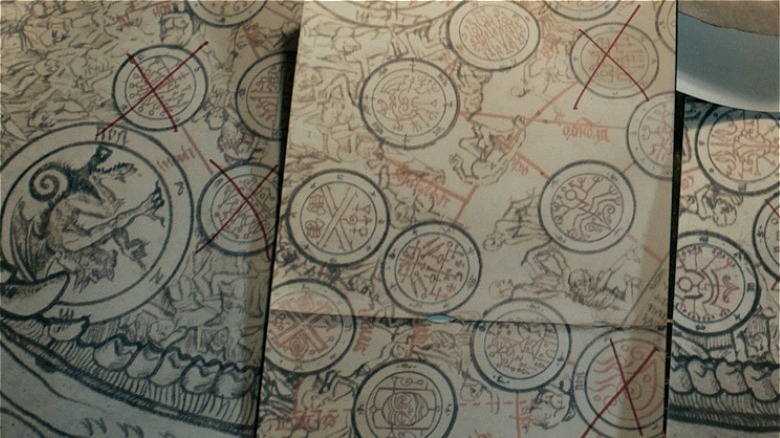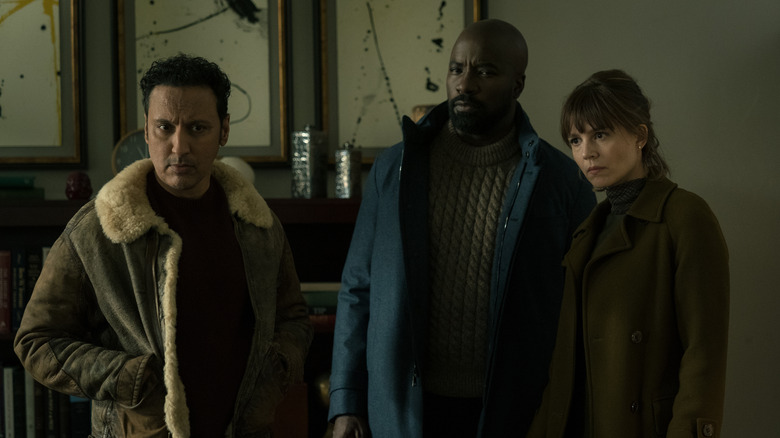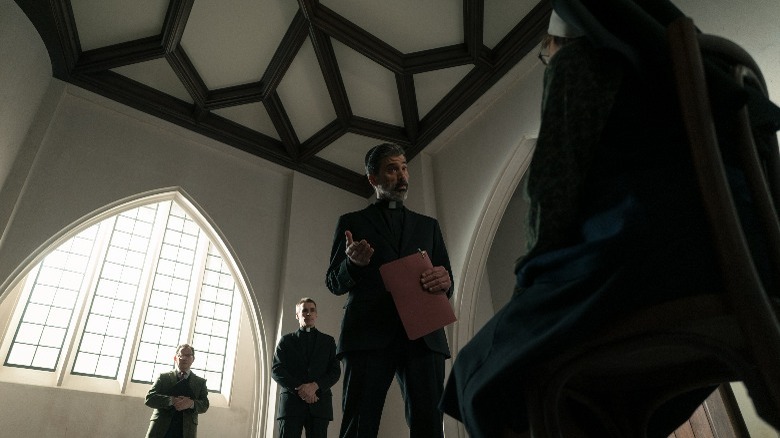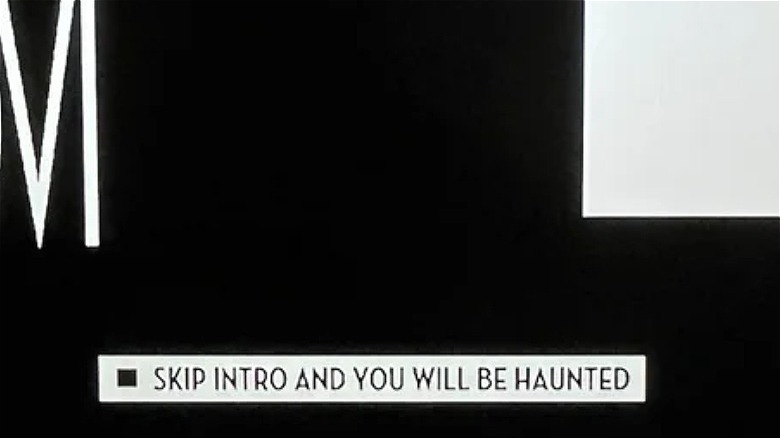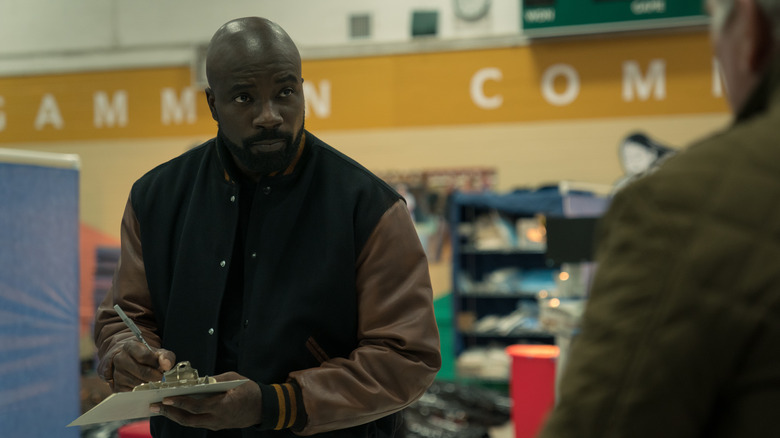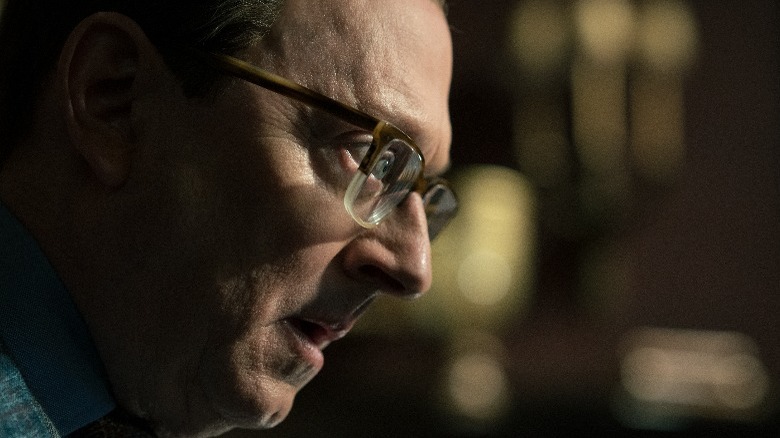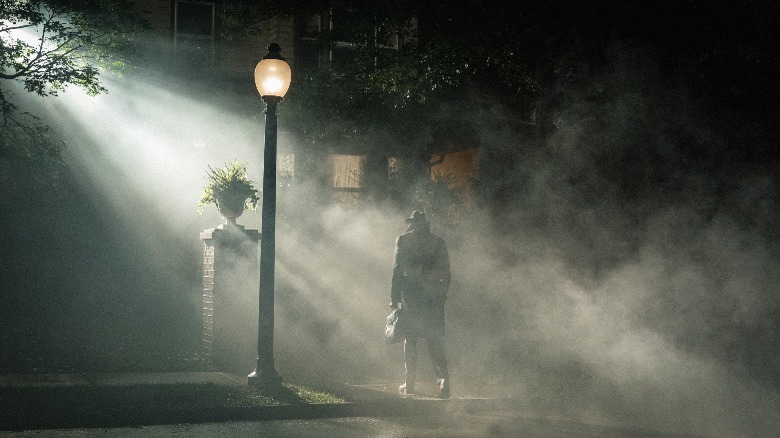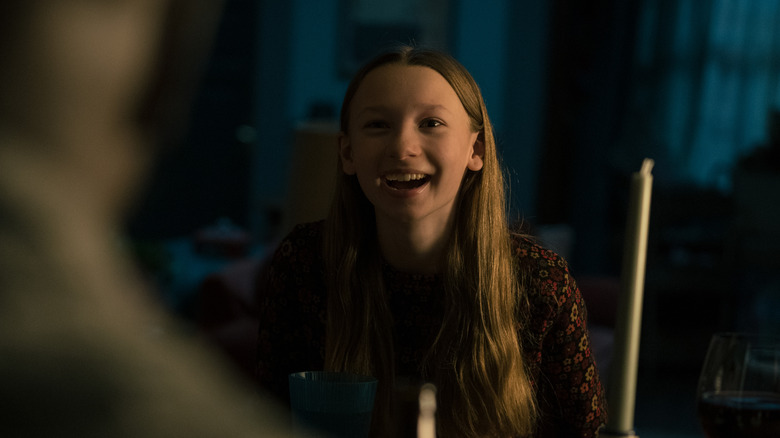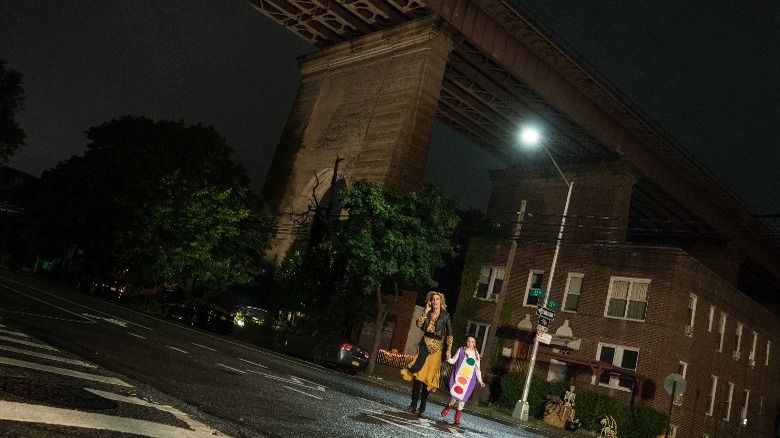The Untold Truth Of Evil
With its exploration of faith, science, and technology, "Evil" is one of the most innovative and ambitious shows on television. More than just a supernatural drama, "Evil" is an often disturbing black comedy from Robert and Michelle King. The series follows priest David Acosta (Mike Colter), skeptic psychologist Kristen Bouchard (Katja Herbers), and tech wizard Ben Shakir (Aasif Mandvi) as they investigate demonic possessions on behalf of the Catholic Church. On the surface, it looks like a simple tug-of-war between religion and science, but as the show progresses, it becomes clear that there's more going on.
"Evil" is brimming with interconnected and often bizarre plot threads that seem to weave into the show's wider mythology — so many, in fact, that viewers almost have to take notes to keep track of everything. Between the Therapist Demon, blood baths, and highway drone attacks, there is never a dull moment for the demon-debunking trio, and the behind-the-scenes of the show is just as interesting. Let's dive into the untold truth of "Evil."
There are hidden puzzle pieces in every episode
It can be a lot of fun to delve into a show's complex mythology and explore fan theories online, but "Evil" adds another layer to the experience by giving fans literal puzzle pieces to look for. The CBS show isn't the first to do something like this. The cult animated series "Gravity Falls" contains cryptograms hidden in the credits, and the sci-fi series "Fringe" contains a glyph puzzle along with hidden Observer sightings in every episode. "Mr. Robot," "Stranger Things," and "Westworld" also contain a puzzle layer woven throughout some of the episodes. But the puzzle piece game hidden in "Evil" takes the cake when it comes to clever puzzles in TV shows — and many fans of the show don't even know it's there.
In "Evil," these subliminal puzzle pieces flash across the screen so quickly that you need to hit pause at just the right time to examine them. Some episodes contain multiple puzzle pieces, and "players" are supposed to collect them through the season so they can put them all together at the end. As if that wasn't enough, according to Unwinnable, Season 1's answer is a key to answering the Season 2 puzzle. For viewers who want to skip the effort, the fan site puzzle-tool.com contains all of the puzzles so far and even shows a map they seem to fit over.
The sigils contain hidden messages
Besides the puzzle pieces that are hidden in every episode, diehard fans also look forward to decoding what they call "Georgie's puzzles," hidden as sigil codes or ciphers somewhere within each episode. Solving the puzzle pieces in Season 1 and Season 2 led fans to an art gallery in New York where they found a sigil decoder to unlock the coded messages. One such message can be found toward the end of the Season 3 episode "The Demon of the End," at 41:44.
The clue is on the first page of Kristen's fertility clinic records. When decoded, the message reads (in part): "Season is over, but the game is not." According to Redditor u/xDucklingx, the message begins with, "Hi, it's me George. Want to play?" and includes a lengthy riddle followed by a series of numbers. Some fans believe the numbers could point to a book cipher (a cipher based on pages, lines, and words, for example) or even Hebrew numerology.
The screens and monitors sometimes contain clues
Fans of "Evil" would do well to heed the hint hidden in the corner of the show's Season 3 trailer that urges viewers to "pay attention." In a show full of subliminal puzzle pieces, clues could be lurking anywhere — and quite a few fans have noticed them hidden on computer screens and monitors in the periphery of the show's main action. Sometimes they are sigil messages, and other times the clue might be a demonic face or another type of hint.
One of the best examples is found in Season 3's "The Demon of Money." The secret is hidden on the website for DFGlobal Solutions, the multi-national company that seems to be connected to a curse. Viewers who paused for a closer look at the website noticed sigils across the bottom of the screen. Another example shows up in Season 2's "A is for Angel" when Ben logs into Leland's computer. If viewers pause the screen for a closer look, they'll notice Leland seems to be using a strange and possibly demonic script.
The Latin on the sigil map may hold some clues
Besides the sigil code, the "Evil" sigil map holds a number of other clues. In between all of the various sigils are beautifully drawn images of angels, animals, creatures, demons, and other strange visuals, all ripe for analysis. The map also contains tiny Latin text, which fans of the show were quick to translate. Twitter user @imaginarylandss shared her self-described "not too accurate translation," explaining that she did not fully understand Latin and had primarily relied on Google translate.
According to the tweet, the text in the outer layer seems to include a line from the nursery rhyme "Ring Around the Roses." The middle layer appears to be a poem about Santa getting high; the inner layer includes a reference to Occam's razor; and the hexagon mentions seeking and finding the occult. And, like everything else in "Evil," it looks like figuring out one puzzle only leads to another.
The numbers in the episode titles are also part of the puzzle
Episode titles that follow a pattern are nothing new. Most episodes of "Scrubs" begin with the word "My" ("My Hero," "My Balancing Act," and "My Last Day," for example), while "The Big Bang Theory" uses scientific or academic-sounding terminology in its titles ("The Hamburger Postulate," "The Middle-Earth Paradigm"). Some shows even hide clues in the titles for viewers to find, like the Season 2 "Breaking Bad" titles that foreshadowed major events in the series. "Evil" creators Robert and Michelle King have also done this in the past, employing a different convention for every season of their previous show "The Good Fight," something that earned the praise of The New York Times.
When Season 1 of "Evil" aired, fans couldn't help but notice a pattern in the episode titles: Every title included a number ("Rose390," "Genesis 1," etc). After fans spent a season discussing the potential for a hidden clue or code, tossing theories around among themselves, the official "Evil" Twitter profile confirmed that there was a puzzle to be solved. It dropped a cryptic tweet reading "One after the other" next to a short video clip of the episode titles swirling around each other and coming together to form "974."
In an interview with Entertainment Weekly, Robert King called the puzzle "fairly complicated," emphasizing that every mystery in the show fits together as part of a larger one. As it turns out, those numbers are part of what helped lead fans to the New York gallery containing the sigil map.
The show uses Dutch angles to set the tone
When it comes to telling a great horror story, form is just as important as content. Directors have been finding ways to make their horror stories feel more intense and ominous for as long as the genre has been in existence, with tools like panning the camera at just the right speed or using a snap zoom to create a jarring effect. When it comes to creating mood, one time-tested cinematic tool is a surefire way to create a sense of general unease without drawing too much attention to itself — the Dutch angle.
The technique, which tilts the camera to create an anxiety-inducing angle, has been around since the silent film era, with one of its earliest appearances occurring in the 1920 German expressionist horror film "The Cabinet of Dr. Caligari." Over the past century, the technique has been used by the likes of David Lynch, Quentin Tarantino, Orson Welles, Stanley Kubrick, and Alfred Hitchcock to establish everything from a general sense of unease to full-blown anxiety, which is why it should come as no surprise that "Evil" creators Robert and Michelle King use the Dutch angle often.
You'll get haunted if you skip the intro
Streaming video platforms like Netflix, Hulu, and Paramount+ have revolutionized the way we watch television in the modern era, and it's not just about binging or rewatching a favorite series. Viewers can now skip through anything they don't want to watch, whether that means fastforwarding through the gory scenes or skipping the credits altogether. And since platforms like Paramount+ offer viewers the option of skipping past the intro, there's no need to watch it unless you really love the visuals or the music.
Still, there are some shows that give viewers a reward for paying attention to the intro. Take shows like "Fringe," "Fear the Walking Dead," and "Supernatural," which change up the intros or title cards to give fans a hint at what's to come. Instead of using title card hints to entice viewers to keep watching, "Evil" takes a more Leland-like approach, resorting to a good old-fashioned threat. While watching Season 3, Episode 6 ("The Demon of Algorithms"), many fans noticed an ominous warning flashing briefly at the bottom of the intro, which read, "Skip the intro and you will be haunted." After stumbling upon it, TikTok user T3Media Studios praised the showrunners, noting, "This show is brilliant with their hidden messages and the things that they put in there to just creep you out."
Mike Colter keeps playing Davids
If you've watched "Evil" from the start, you've probably noticed that it contains an unexpectedly high number of Eddies and Edwards. First, there's Leland's skeezy business buddy Edward Tragoren (Tim Matheson), and then there are those freaky Eddie dolls that seem to keep popping up all over the place. And just as Kristen Bouchard seems to be haunted by Eddies, actor Mike Colter, who plays priest David Acosta, keeps bumping into the name David.
As the hunky priest with one of the best wardrobes in the prayer trade, Mike Colter's nuanced portrayal manages to beautifully capture the interplay of tenderness, compassion, inner turmoil, and masculine strength that make his character David Acosta a pure pleasure to watch. While the actor is perhaps best known for his portrayal of Marvel's Luke Cage, his role as Father Acosta is Colter's fourth portrayal of a character named David.
Colter's first David appeared on "Law & Order: Criminal Intent," on which he played murder-minded chauffer Dave Oldren in the Season 6 episode "Albatross." He appeared in another supernatural cult favorite when he showed up as a witch hunter named David on "American Horror Story: Coven," appearing in three episodes. And in 2018, Colter portrayed another enigmatic David in the science-fiction film "Extinction."
One storyline unsettled Michael Emerson
Michael Emerson has played some dark and troubled characters during his career, often appearing in storylines that explore some pretty heavy content. His role as serial killer William Hinks on "The Practice" won him a Primetime Emmy, and he would earn another for his portrayal of Ben Linus on "Lost," the unflinching leader of the Others who casually ordered killings and once used a chemical weapon to wipe out the Dharma Initiative community. While Emerson enjoys playing villains, telling Closer Weekly that he finds these roles "a great deal of fun," the actor found one piece of writing a bit harder to absorb than the others. The actor discussed the "Evil" episode in question during an exclusive interview with Looper.
In Season 1's "Exorcism Part 2," Emerson's character Leland prods an incel to act on his violent, misogynistic thoughts. Just like most arcs in "Evil," there's a darkly hilarious twist in the story that thankfully thwarts Leland's dastardly plans. The story was so dark that Emerson had his reservations. "I had to get some reassurances that this wasn't too far, that this wasn't beyond the pale, that this wasn't somehow a destructive performance in the real world," he told Looper. In the end, the payoff was "breathtaking," he said. The Kings infused the tale with their trademark blend of pitch black humor and socio-political critique, making for a memorable episode.
The show pays homage to classic horror films
"Evil" creators Robert and Michelle King have spoken extensively about the influence of classic horror films on "Evil," and fans of the genre will find plenty of references and tributes hidden within the show. The Kings explored these influences in the "Evil" CBS short "Horror Movies and Their Influence." The short begins with an observation from Robert, who explains, "I think horror connects you with that sense of being in the woods, being in a campsite, and not knowing what is beyond."
Among the show's influences, the Kings list "Rosemary's Baby" for its depiction of the "elegant side of horror," and "The Exorcist," with the showrunners recreating the famous street lamp scene from the film frame-by-frame — a scene that actor Kurt Fuller (who plays Dr. Kurt Boggs) says he was "just thrilled" to duplicate. "Evil" also includes an homage to Stephen King's "Misery" in "Room 320" (Season 1, Episode 11), and in "Rose390" (Season 1, Episode 4), the VR headset conjures a scene that echoes the twins in the hallway from "The Shining."
There's a fan theory that Lexis knows more than she's letting on
One of the main storylines in "Evil" is the demonic child trope explored through young Lexis Bouchard (Maddy Crocco). Lexis is the only Bouchard child to be conceived through the dubious RSM Fertility, which may or may not be genetically engineering demon spawn. As Lexis matures, she develops teeth so sharp she requires oral surgery, and she soon begins to realize she has a demonic, reptilian tail that no one else seems to see — both signs that she may be half demon.
Despite the fact that her grandma Sheryl and Leland seem to be working together to groom her for a demonic path, fans can't help but notice that Lexis' demonic traits don't seem to outweigh her good nature. She has no problem with throwing Leland under the bus time and time again, selling him out to her mom and plotting with her sisters to burn his Bumblebee Valley house to the ground. When Sheryl decides to test Lexis by introducing her to the Manager Demon in Season 3's "The Demon of Parenthood," Lexis doesn't react to his demonic form, giving him a friendly smile and politely handing him a box of biscuits. Sheryl promptly reports her findings to Leland, telling him, "I think you're wrong about Lexis." But many fans aren't as easily convinced.
While Lexis once hid her tail under baggie clothing and was often seen isolating from her sisters, she seems to be more confident and self-aware toward the end of Season 3, almost as if she understands who she is and doesn't want to play Leland's game. As Redditor u/marycem put it, "Maybe she's like Sr Andrea and sees them everywhere so it doesn't faze her." And as several other Redditors observed, free will — a theme central to Judeochristian theology — could play a role in Lexis' story.
Kristen's house is at the base of Hell Gate Bridge
Like "The Shining," "Evil" is one of those stories where the setting is almost a character in itself. Protagonist Kristen Bouchard lives with her family in a somewhat crowded brick duplex positioned almost directly underneath a New York railroad bridge. Although the Bouchards may have outgrown it, forcing them to add onto the home with a new bathroom build, the adorable domicile seems like something of a rare find in the NYC housing market with its small-but-adequate lawn and outbuilding.
Many viewers from the area speculate it would cost several millions in the real world, despite the close proximity to a miserably loud train track. According to The Cinemaholic, the name of the location is Hell Gate Bridge, and it runs from Queens to Manhattan. It's just another one of those fantastic layers that makes "Evil" one of the most cleverly written shows on television.
